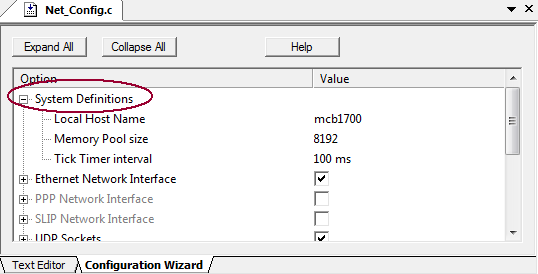|
||
| Products Download Events Support Videos | ||
Technical Support
On-Line Manuals
RL-ARM User's Guide (MDK v4)


 System Definitions
System Definitions
System Definitions allow configuring general device options. The options are set in the file Net_Config.c directly or using the Configuration Wizard.

Where
-
Local Host Name specifies the name of the device within
the network. The name length is limited to 15 characters. This
option corresponds to #define LHOST_NAME.
#define LHOST_NAME "mcb1700" // maximal 15 characters allowed
-
Memory Pool size specifies the amount of RAM in bytes
allocated for the Memory Pool. Values between 1500 and 64000 are
allowed. The default value is 8000. This option corresponds to
#define MEM_SIZE. The Memory Pool size value is
transformed into a 4-byte value that is assigned to
MEM_SIZE. For example, the Memory Pool size value of
8192 is transformed into #define MEM_SIZE 2048.
#define MEM_SIZE 2048 // Memory Pool size value is 8192 bytes !!
-
Tick Timer interval specifies the System Tick Timer
interval value in milliseconds. Values can be selected from a
list. The default value is 100ms. This option corresponds to
#define TICK_INTERVAL.
#define TICK_INTERVAL 100 // value in milliseconds
ProductsDevelopment Tools |
Hardware & Collateral |
Downloads |
Support |
Contact |
